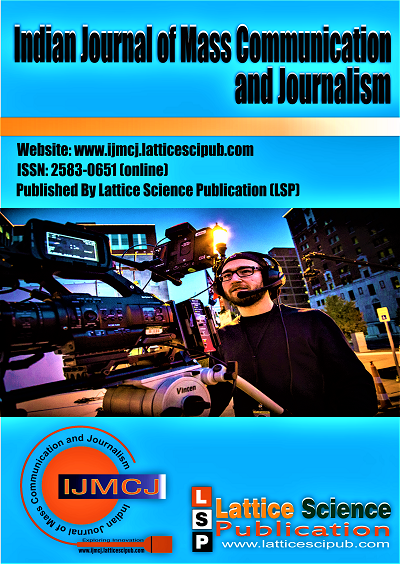Usage of Facebook by Student Leaders in Creating Awareness Regarding Covid-19 in Guwahati
Main Article Content
Abstract
Pandemic like COVID-19 has triggered disruptions in personal and collective lives globally. It is not only a pandemic, but also an Infodemic of misinformation about the virus which raises demand for reliable and trustworthy information. With the advent of social media creation and consumption of news have been changing among the young generation. Student leaders have taken on additional work and assumed new responsibilities by volunteering in their communities and creating awareness among the public about the accuracy of information and measures to be taken against the deadly virus. This study explores the use of Facebook handles by the student leaders of two universities in Guwahati in creating awareness about the health-related messages regarding Covid-19 and its vaccination. The researcher will use critical discourse analysis to evaluate the use of social networking sites by the students’ leaders. To understand the usage by the leaders, Facebook pages of the leaders would be followed and studied backed with unstructured interviews with the leaders to understand the purpose of and pattern of using the social media handles.
Downloads
Article Details

This work is licensed under a Creative Commons Attribution-NonCommercial-NoDerivatives 4.0 International License.
How to Cite
References
(2020). COVID-19 and the youth of today, leaders of tomorrow. WHO.
Iivari, N., Sharma, S., & Olkkonen, L. V. (2020). Digital transformation of everyday life – How 3. COVID-19 pandemic transformed the basic education of the young generation and why information management research should care? Elsevier Public health emergency Collection. doi:https://dx.doi.org/10.1016%2Fj.ijinfomgt.2020.102183 [CrossRef]
Kniffin, K. M., Narayanan, J., Anseel, F., Antonakis, J., & Bapuji, H. (2020). COVID-19 and the Workplace: Implications, Issues, and Insights for Future Research and Action. Harvard Business School. [CrossRef]
Mariën, I., & Prodnik, J. A. (2014). Digital inclusion and user (dis)empowerment: a critical perspective. Emarald Insight, 16(6), 35-47. doi:http://dx.doi.org/10.1108/info-07-2014-0030 [CrossRef]
(2020). Mental health and psychosocial considerations during the COVID-19 outbreak. World Health Organisation.
Mourad, A., Srour, A., Harmanani, H., Jenainati, C., & Arafeh, M. (2020). Critical Impact of Social Networks Infodemic on Defeating Coronavirus COVID-19 Pandemic: Twitter-Based Study and Research Directions. Retrieved from arXiv:2005.08820v1 [CrossRef]
Mourad, A., Srour, A., Harmanani , H., Jenainati, C., & Arafeh, M. (2020, May 18). Critical Impact of Social Networks Infodemic on Defeating Coronavirus COVID-19 Pandemic: Twitter-Based Study and Research Directions. Retrieved from arXiv:2005.08820v1 [CrossRef]
Reese, S.D., Gandy, O.H. & Grant, A.E. (eds). 2003. Framing public life: Perspectives on Media and Our Understanding of the Social World. Mahwah, NJ: Lawrence Erlbaum.
Reynolds B, Seeger MW. Crisis and emergency risk communication as an integrative model. Journal of Health Communication 2005; 10:43–55. [CrossRef]
Russonello, G. 2020a. “Afraid of Coronavirus? That Might Say Something About Your Politics.” March 13. https://www.nytimes.com/2020/03/13/us/politics/coronavirus-trump-polling.html
Saha, K., Torous, J., Caine, . D., & Choudhury, M. D. (2020, August 11). Social Media Reveals Psychosocial Effects of the COVID-19 Pandemic. MedRxiv. doi:https://doi.org/10.1101/2020.08.07.20170548; [CrossRef]
Taha SA, Matheson K, Anisman H. 2009. H1N1 Influenza Pandemic: the role of threat, coping, and media trust on vaccination intentions in Canada. J Health Commun. (2013) 18:278–90. DOI: 10.1080/10810730.2012. 727960 [CrossRef]
Talukdar, M. (2020). Moon Talukdar. Retrieved from Facebook: facebook.com/moon.talukdar.752861
Taylor, D. B. (2020, August 6). A Timeline of the Coronavirus Pandemic. Retrieved from The New York Times: https://www.nytimes.com/article/coronavirus-timeline.html
Terkildsen, N. & Schnell, F. 1997. How Media Frames Move Public Opinion: An Analysis of the Women’s Movement. Political Research Quarterly 50(4): 879-900. Tuchman, G. 1978. [CrossRef]
Templeton, A., Guven, S. T., Hoerst, C., Vestergren, S., Davidson, L., Ballentyne, S., . . . Choudhury, S. (2020). Inequalities and identity processes in crises: Recommendations for facilitating safe response to the COVID-19 pandemic. The British Psychological Society, 59, 674–685. doi:10.1111/bjso.12400 [CrossRef]
Wimmer, R., & Dominick, J. R. (2011). Mass Media Research. Wadsworth CENGAGE Learning.
World Health Organization: Implementation of the International Health Regulations (2005): report of the review committee on the functioning of the International Health Regulations (2005) in relation to pandemic (H1N1) 2009. In Sixty-Fourth World Health Assembly. Geneva: World Health Organization; 2011. http://apps.who.int/gb/ebwha/pdf_files/WHA64/A64_10- en.pdf
World Health Organization. (2020) WHO DirectorGeneral’s opening remarks at the media briefing on COVID-19—11 March 2020.
World Health Organization. (2003). Consensus document on the epidemiology of severe acute respiratory syndrome (SARS) (No. WHO/CDS/CSR/GAR/2003.11). World Health Organization.
worldometer. (2020, September 29). Retrieved from Coronavirus: www.worldometers.info
Wood, J.T. 2004. Communication Theories in Action. An Introduction. (3rd edition). Canada: Thomson Wadsworth.
Ying Liu, Albert A Gayle, Annelies Wilder-Smith, and Joacim Rocklöv. 2020. The reproductive number of covid-19 is higher compared to sars coronavirus. Journal of travel medicine.
Yoon, J., Hagen, L., Andrews, J., Scharf, R., Keller, T., & Chung, E. (2019, June). On the use of multimedia in Twitter health communication: analysis of tweets regarding the Zika virus. Information Research, 24(2). Retrieved from http://www.informationr.net/ir/24-2/paper823.html
Yu, N., Frohlich, D. O., Fougner, J., & Ren, L. (2011). Communicating a Health Epidemic: A Risk Assessment of the Swine Flu Coverage in US Newspapers. International Public Health Journal 3(1, Special Issue on “Health Risk Communication”), 63-76.
Zhao, Y., & Xu, H. (n.d.). Chinese Public Attention to COVID-19 Epidemic: Based on Social Media. Retrieved from MedRxiv: https://doi.org/10.1101/2020.03.18.20038026





